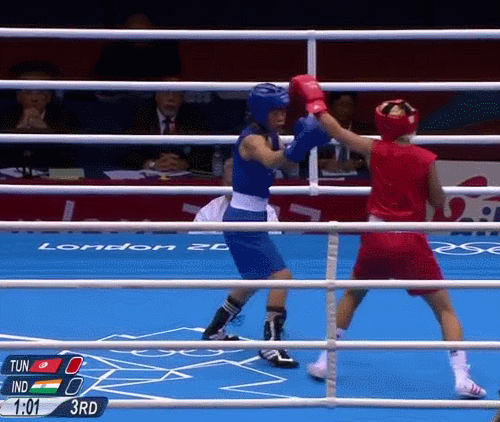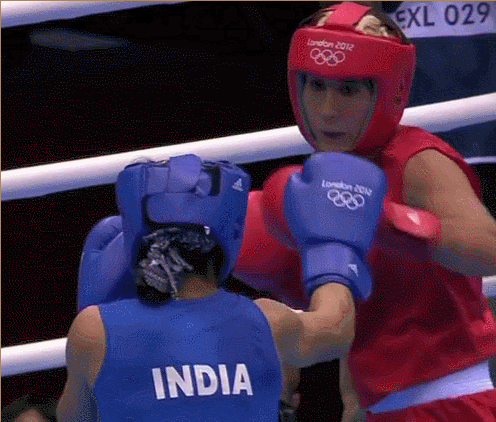Mary Kom: Southpaw Techniques and Tactics from “The Magnificent” Part 1: 2007 - 2012
After clinching the World Championship for a record-breaking 6th time (surpassing current pro Katie Taylor’s previous women’s record) she continues to be one of the most decorated athletes from South Asia. Much is said of her feats, but not enough about how she’s doing it. How is she beating people up and taking home shiny things?
In this article, we’ll explore Kom’s technique from 2007 (the earliest competitive and clear video I could find of her) up until 2012 at her Olympic performance in London.
-Southpawism and Unmatched Leads-
Kom fight’s Southpaw (right foot forward), while most of her opponents are Orthodox (left foot forward).
This creates what is called Unmatched Leads situation, in which the lead legs of both fighters are directly in front of each other. (Here’s an article about Unmatched Leads )
Why is this important? Because most of Kom’s tactics and techniques are based on her being Southpaw and her lead leg being close to her opponent’s. With Unmatched Leads, the jab tends to become less important, because the lead hands are so close to each other. The rear hand, however, becomes a more viable option because the opening of the guard faces toward the opponent’s rear side and the space allows for acceleration.
Kom uses a fundamental group of movements and attacks to do most of her damage. We’ll dissect them into individual components.
-The Outside Slip and Forward Crouch-
This is some basic evasion that Kom uses frequently and to great success against her opponents’ straights and hooks. By slipping, she has removed her head from the centerline, and put herself outside of her opponent’s arms.
Kom might also step with the slip or crouch to exaggerate her position on her opponent. Notice how she weaved out with a hop to avoid the second punch and her opponent takes a follow-through step forward.
Alone the head movement is neat, but what it really does is forces the opponent to want to slow down the spry Kom. This means they find themselves entering into her range and falling prey more readily to the following attacks.
-The Advancing or Slipping Straight-
For an advancing Straight/Cross (technically, it’s a “cross” only when it goes over the opponent’s arm), Kom frequently steps forward with the right foot and delivers a left straight simultaneously. Otherwise, (and more commonly if the opponent is around her height) she will slip to her right and throw her left straight.
Why is this such a great attack?
For a few reasons:
a) It’s a power punch
b) Against an orthodox opponent, the opening of their guard faces her rear hand
c) If she’s stepped, it makes any attack by the opponent much more predictable and awkward. Most boxers once they’ve been out-flanked will attempt to re-establish space.
AND
d) It sets up another one of her power punches:
-The Left Straight - Right Hook (“2-3”) Combo-
Off of the Cross, Kom is outside of her opponent’s lead side and has set herself beautifully to deliver a lead hook. Much of the time, this is going over the arm or shoulder.
After attacking with a 2-3, Kom is usually in “The Pocket”: That sweet mid-range where she can put full force behind all her attacks. Once there, she has a tendency to open up and continue throwing 2’s and 3’s until her opponent resets the distance or clinches.
Notice that because she’s positioned herself on the outside, she can let fists fly with Rick Sanchez-levels of impudence.
She throws so much heat on this hook, that it has a tendency to turn her around when she misses.
While advancing is one option, Kom can also throw a check hook (or step-back lead hook) instead. This is what some coaches and analysts call “Closing the Door” as, even if it misses, it puts a barrier between you and your opponent.
It’s worth noting that many of Kom’s hooks come in wide, that is, with the inside of palm landing instead of the fist. This would not “score” in traditional amatuer boxing rules, but it is nonetheless jarring if the opponent’s stumbling is any indication. Some might recall Joe Calzaghe throwing hooks similarly, and of course, Nick and Nate Diaz have nearly patented their very blatant “Stockton Slap”. All of the fighters listed are Southpaw, oddly enough.
While Kom can throw the 2-3 from most anywhere. She’ll sometimes set it up with a brilliant tactic.
-The Lead Hand Trap-
Lastly, we see her baiting her opponents, especially those with a reach advantage on her, with an age old trick: The Lead Hand Trap.
Since both lead hands are so close to each other, she often attempts to cover her opponent’s lead hand with her own.
If the hand is allowed to stay there, this leaves a single option: the opponent throws their own right hand. This sets off a chain reaction that leads to Ouchie Town. In the below gif, the trapping hand is so close it is almost on the opponent’s face.
We’ll wrap up with a sequence that ties it all together, an exchange that looks like it was choreographed by Donnie Yen.
Lead Hand Trap —> Outside Slip —> Cross - Lead Hook - Straight, while evading the opponent’s wide hook
Much of Kom’s early offense revolves around slipping the straight, stepping or slipping in with a cross to get a favorable angle on her generally orthodox opponents, and then finishing with a lead hook. Rinse, repeat. She’ll sometimes use the lead hand trap to draw out a straight she can counter.
These techniques used by Kom are fundamental, but rely on good timing and a finger on the trigger to pull off at such high levels. In combination they have made her a perennial shoe-in for the world championship. In the next article, we’ll examine the adjustments she has made since 2012 to maintain her supremacy and carve out her legacy.
Until next time! Hugs!













